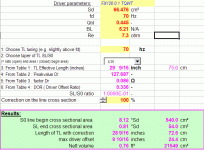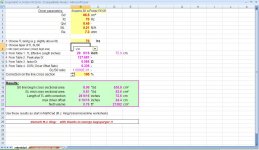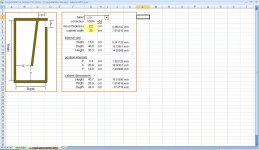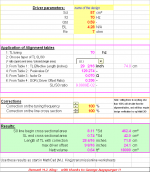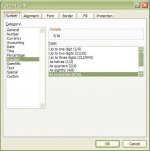the Alpair10 (or Alpair12) would be a good candidate thenSo what I get from this is I need to pick a speaker that has a lower Fs and use its Fs in all calculations.
the Alpair10 (or Alpair12) would be a good candidate then
Those are some nice looking drivers. I like the gold color as one can match it with a wood cabinet.
Ok which MJK worksheet do I need to use for this design.
I take you resolved your issues with the Excel designer(s)?
Anyway, yes, for the most accurate sim it will require the 'sections' WSs, but first you will have to unfold the Seas TQWT and convert it to its equivalent circular sections to input it since the MathCad WSs are only 1D, i.e. it only sims an axial length solution with no consideration for any changing width-depth aspect ratios.
That said, stuffing ameliorates any audibly subtle difference, so as Henkjan noted, a simple two fold layout can be simmed accurately enough. For sure, its variance will be far < the likely difference that published Vs measured driver specs are going to cause. The 'beauty' of TLs though is they have plenty of tuning flexibility if they don't start off too acoustically small for the driver's actual specs and why I recommend making it a bit bigger than the published specs indicate. So in retrospect, using the 'Correction on the line cross section' feature to add at least 10% to the design wouldn't hurt if it doesn't make the cab unacceptably big.
GM
I take you resolved your issues with the Excel designer(s)?
Anyway, yes, for the most accurate sim it will require the 'sections' WSs, but first you will have to unfold the Seas TQWT and convert it to its equivalent circular sections to input it since the MathCad WSs are only 1D, i.e. it only sims an axial length solution with no consideration for any changing width-depth aspect ratios.
That said, stuffing ameliorates any audibly subtle difference, so as Henkjan noted, a simple two fold layout can be simmed accurately enough. For sure, its variance will be far < the likely difference that published Vs measured driver specs are going to cause. The 'beauty' of TLs though is they have plenty of tuning flexibility if they don't start off too acoustically small for the driver's actual specs and why I recommend making it a bit bigger than the published specs indicate. So in retrospect, using the 'Correction on the line cross section' feature to add at least 10% to the design wouldn't hurt if it doesn't make the cab unacceptably big.
GM
No I have not resolved the issues. If you remember one of the post where I asked about the dimensions I was getting. I got them from the excel work sheet. Then you said you where getting different measurements. That issue still exists. I have no clue as to why they are so off. I expect height to give one the TL length needed not fatness as that will only give you volume. The original design I am basing mine off of are about 14 inch depth and 3 1/2 ft high which seems right to me and I am getting nothing like that. Instead I am getting a very square type box. No GOOD.
OK, which Excel WS? Henkjan's or the one on MJK's site?
Regardless, not having worked out the Seas's TQWT average reverse taper, here's an example of a 70 Hz 1/10 taper (AKA 0.1 in MJK 'speak') using the FX120's published and necessary derived specs and hopefully when you input these values you'll get the same results. If not, then the SS is corrupted.
From this we see that the 'as built' axial line length is 28.56" with a theoretically ideal driver offset from (SO) of 9.625". The top closed area (SO) is 540 cm^2 and the open end 'vent' area is 1/10 this or 54 cm^2. Using CONVERT or other conversion program, this equates to SO = ~83.7"^2/SL = ~8.37"^2, so strictly for purposes of example, making its cross sectional area (CSA) initially square, its width/depth = ~ SQRT 83.7 = ~9.15". I prefer to use either the golden or one of the acoustic ratios for cosmetic reasons, but being well damped to smooth out the pipe's upper harmonics it doesn't matter like it does in large vented, sealed cabs. The main thing is not to make width:depth a very high aspect ratio (> 9:1) due to potentially rolling off its LF output too much when combined with stuffing.
For my own edification, I compared its ~0.6531 ft^3 net Vb (not sure how the listed 0.76 ft^3 Vb was calculated) to a simple 70 Hz Fb bass reflex and it sims a ~+3 dB peak at Fb, a rule-of-thumb that I've used with good results for decades, so at least based on published specs it looks like a 'winner', if at least an 80 Hz/2nd order XO is used and maybe some baffle step compensation (BSC) if there's not enough room gain to offset it enough.
GM
Regardless, not having worked out the Seas's TQWT average reverse taper, here's an example of a 70 Hz 1/10 taper (AKA 0.1 in MJK 'speak') using the FX120's published and necessary derived specs and hopefully when you input these values you'll get the same results. If not, then the SS is corrupted.
From this we see that the 'as built' axial line length is 28.56" with a theoretically ideal driver offset from (SO) of 9.625". The top closed area (SO) is 540 cm^2 and the open end 'vent' area is 1/10 this or 54 cm^2. Using CONVERT or other conversion program, this equates to SO = ~83.7"^2/SL = ~8.37"^2, so strictly for purposes of example, making its cross sectional area (CSA) initially square, its width/depth = ~ SQRT 83.7 = ~9.15". I prefer to use either the golden or one of the acoustic ratios for cosmetic reasons, but being well damped to smooth out the pipe's upper harmonics it doesn't matter like it does in large vented, sealed cabs. The main thing is not to make width:depth a very high aspect ratio (> 9:1) due to potentially rolling off its LF output too much when combined with stuffing.
For my own edification, I compared its ~0.6531 ft^3 net Vb (not sure how the listed 0.76 ft^3 Vb was calculated) to a simple 70 Hz Fb bass reflex and it sims a ~+3 dB peak at Fb, a rule-of-thumb that I've used with good results for decades, so at least based on published specs it looks like a 'winner', if at least an 80 Hz/2nd order XO is used and maybe some baffle step compensation (BSC) if there's not enough room gain to offset it enough.
GM
Attachments
OK, which Excel WS? Henkjan's or the one on MJK's site?
Regardless, not having worked out the Seas's TQWT average reverse taper, here's an example of a 70 Hz 1/10 taper (AKA 0.1 in MJK 'speak') using the FX120's published and necessary derived specs and hopefully when you input these values you'll get the same results. If not, then the SS is corrupted.
From this we see that the 'as built' axial line length is 28.56" with a theoretically ideal driver offset from (SO) of 9.625". The top closed area (SO) is 540 cm^2 and the open end 'vent' area is 1/10 this or 54 cm^2. Using CONVERT or other conversion program, this equates to SO = ~83.7"^2/SL = ~8.37"^2, so strictly for purposes of example, making its cross sectional area (CSA) initially square, its width/depth = ~ SQRT 83.7 = ~9.15". I prefer to use either the golden or one of the acoustic ratios for cosmetic reasons, but being well damped to smooth out the pipe's upper harmonics it doesn't matter like it does in large vented, sealed cabs. The main thing is not to make width:depth a very high aspect ratio (> 9:1) due to potentially rolling off its LF output too much when combined with stuffing.
For my own edification, I compared its ~0.6531 ft^3 net Vb (not sure how the listed 0.76 ft^3 Vb was calculated) to a simple 70 Hz Fb bass reflex and it sims a ~+3 dB peak at Fb, a rule-of-thumb that I've used with good results for decades, so at least based on published specs it looks like a 'winner', if at least an 80 Hz/2nd order XO is used and maybe some baffle step compensation (BSC) if there's not enough room gain to offset it enough.
GM
Seems my knowledge is very limited. I have just about the same thing you just posted, but the other points you make are where my knowledge ends. I will post what I have. Now, where my confusion is the second page where it is suggesting measurements. The values are a square box. TO see what I am talking about look at cabinet measurements. Anyway, I will look into what you have written and come up with my own measurements.
Thank You
Attachments
OK, your differing dims on pg. 1 are due to your rounding up of Sd, so not an issue.
WRT pg. 2, I forgot there was one or I would have used the same aspect ratio for my example to make it less confusing. Sorry about that.
Regardless, as you can see, with such a short line there's no way to get even close to the proportions of the Seas pipe, though it will at least have a similar one if you don't fold it. Just fill the leftover rear cavity with damping to keep it from resonating.
GM
WRT pg. 2, I forgot there was one or I would have used the same aspect ratio for my example to make it less confusing. Sorry about that.
Regardless, as you can see, with such a short line there's no way to get even close to the proportions of the Seas pipe, though it will at least have a similar one if you don't fold it. Just fill the leftover rear cavity with damping to keep it from resonating.
GM
you mean in my Excel sheet? simply the length times the average cross section of the line (using the values just above it in the green results box)(not sure how the listed 0.76 ft^3 Vb was calculated)
you mean in my Excel sheet? simply the length times the average cross section of the line (using the values just above it in the green results box)
Thanks, understood (now), but at the time I'd forgotten about pg. 2/folded in my haste to move on, so calc'd just the net unfolded pipe Vb........
Regardless, both Vbs sim close enough to identical, so it's academic.
GM
I have updated the sheet with the corrections in a separate box and default tuning=fd
Thanks for the continuing effort and if it's not asking for too much, including converting all values on both pages to Imperial and reducing fractions to their lowest common denominator along with cm^3 listed in liters for the English version would be 'icing on the cake'.
GM
the units I'll work on, for the fractions I'm in Bill Gates' hands, since excel does that in the number format
a request: could the US and the UK guys please indicate what imperial units they like for lenght, volume, area, etc. I'll try to make a drop down box with some options (SI, metric, UK, US)
a request: could the US and the UK guys please indicate what imperial units they like for lenght, volume, area, etc. I'll try to make a drop down box with some options (SI, metric, UK, US)
the units I'll work on, for the fractions I'm in Bill Gates' hands, since excel does that in the number format
a request: could the US and the UK guys please indicate what imperial units they like for lenght, volume, area, etc. I'll try to make a drop down box with some options (SI, metric, UK, US)
Inches and Feet for US
I will post the most common conversions in a bit.
the units I'll work on, for the fractions I'm in Bill Gates' hands, since excel does that in the number format
a request: could the US and the UK guys please indicate what imperial units they like for lenght, volume, area, etc. I'll try to make a drop down box with some options (SI, metric, UK, US)
Interesting, I was under the impression that Excel was a fairly powerful in such aspects.
Hmm, I thought the UK used only SI units these days, leaving us to carry the 'flag' for their Imperial Units. Regardless, in the USA most folks still use rulers marked in fractions of an inch AFAIK and few use the 1/32 demarcations, so...........
length = inches rounded to nearest 1/16
area = square inches rounded to nearest 1/16 (in^2)
volume = cubic foot rounded to nearest 1/48 fraction (ft^3)
GM
Oops! didn't see your post Josh, sorry about that.
Last edited:
Inches and Feet for US
I will post the most common conversions in a bit.
Here is a little site I found that has most of the common ones.
Conversion tables, tables to convert between metric and standard measurements
It is simple and does not round the conversion number too bad.
IE mm to in = .1/2.54 = 0.03937007874015748031496062992126
where the site has mm to in being 0.03937
O and you can easily have excel do 1/16. I have uploaded pic to show.
Also not that one can do a custom format and use "# ??/32" for 32 or "# ??/16"(same as what pic has only custom done). So for 48th as GM asked for one would need to use custom and use "# ??/48". Plz, note that this will always do it in what ever denominator picked and will not do any reducing for example 8/16 = 1/2, but will show up as 8/16. There is no easy way around this, but it is not a big deal anyway. It just might bug some people. Let them get over it.
Thanks for the sheet.
Attachments
Last edited:
Interesting, I was under the impression that Excel was a fairly powerful in such aspects.
Hmm, I thought the UK used only SI units these days, leaving us to carry the 'flag' for their Imperial Units.
mostly true, except that most folks over 18 still understand inches better, me included. volume and weight however have been metric for some time here, and even before they went metric they still used different imperial measures to the US anyway
eg one Oz = 28g
one pound = 454g
one gallon = 4.5(somthing) litres
Last edited:
excel sheet discussion in continued in a separate thread
http://www.diyaudio.com/forums/full-range/163394-tl-alignment-tables-excel.html
http://www.diyaudio.com/forums/full-range/163394-tl-alignment-tables-excel.html
Hmm, I thought the UK used only SI units these days, leaving us to carry the 'flag' for their Imperial Units.
Officially we're SI based, although most notably in motoring terms, we still stick with the Imperial units, everything being in miles, mph etc. I generally stick with Imperial or tweaked versions thereof even though I nominally grew up in the SI age.
Hello,Seems my knowledge is very limited. I have just about the same thing you just posted, but the other points you make are where my knowledge ends. I will post what I have. Now, where my confusion is the second page where it is suggesting measurements. The values are a square box. TO see what I am talking about look at cabinet measurements. Anyway, I will look into what you have written and come up with my own measurements.
Thank You
how did you invert the box shape on the second page of the Sheet as you have shown In the second figure.
- Status
- This old topic is closed. If you want to reopen this topic, contact a moderator using the "Report Post" button.
- Home
- Loudspeakers
- Full Range
- Help a new guy with TL enclosure
